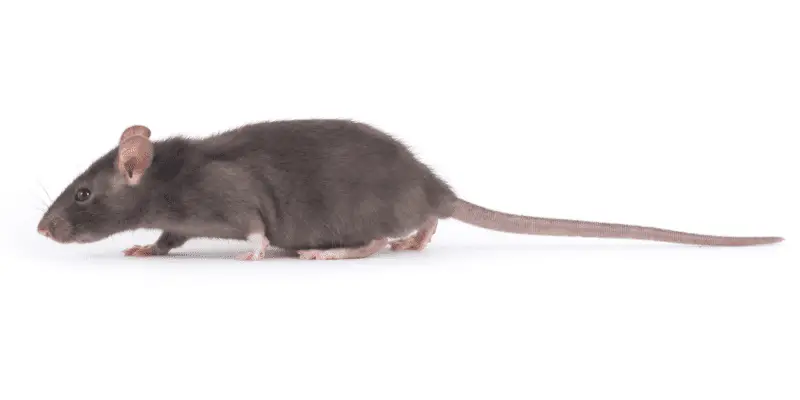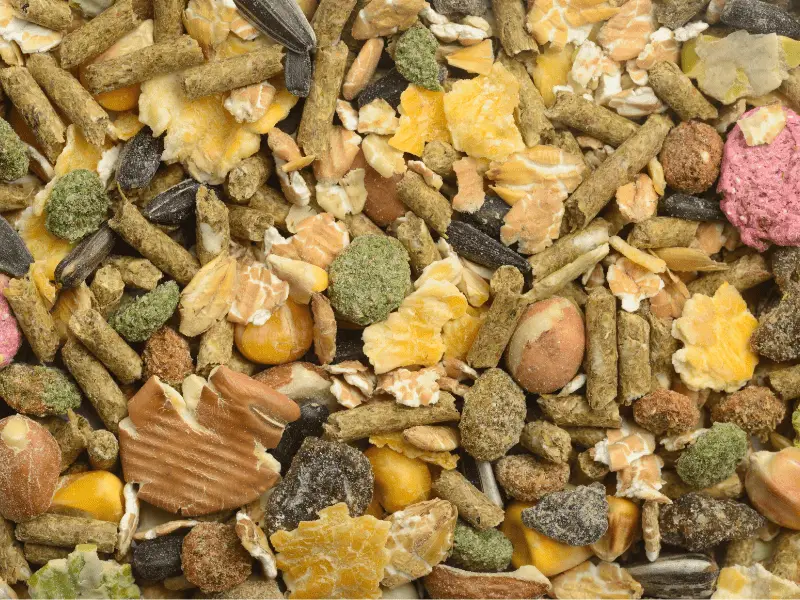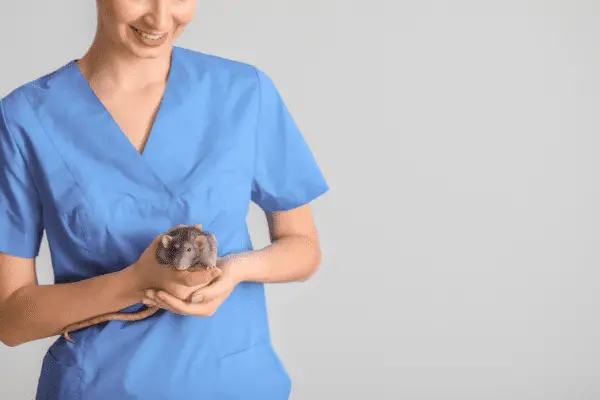This article contains affiliate links, and we may earn a commission at no cost to you if you choose to purchase through these links. I never recommend products that I do not trust or will not advise my veterinary clients and patients to use.
Rat owners can easily miss weight loss if the change is slow and gradual, especially when you still see your rat eating. Since rats are small and fluffy, it can be even more challenging to notice small changes in body weight. Rat parents will usually only see weight loss when the bony prominences of the spine and pelvis are easily palpable. In which case, they have already lost more than 10% of their ideal body weight.
Healthy body weight for a particular rat varies greatly depending on breed and sex. Rat owners should monitor for changes in their rat’s weight by weighing them regularly. Male rats can weigh between 260 – 500g, and female rats can weigh between 230 to 350g. In addition to weighing, visual body condition scoring is a much more reliable way to determine a healthy weight.
Common reasons pet rats unintentionally lose weight include dental problems, poor diet, internal parasites, and chronic health conditions.
How Do I Tell Wheter My Rat Is Underweight?
In a rat with a healthy body weight, you should not be able to feel their ribs when just placing your fingers on either side of their chest, but you should be able to feel the ribs when applying light pressure.

You should not be able to see any of the prominences of the vertebral bodies of the spine but should be able to feel the spine when applying light pressure. You should be able to feel the muscle running on either side and parallel to the spine, i.e., there should not be a groove on either side of the spine. The shoulder blades and pelvis should be well covered by muscle tissue.
If you can see individual spiny processes or see the outline of the pelvis or scapula, your rat is severely underweight.


To avoid missing the small changes in your rat’s body weight, I advise rat owners to weigh their rats at least once every few weeks and at least once a week after your rat turns two years old or when they are sick. Just a regular old kitchen scale will do the job, but your bathroom scale will not, as you need a scale that will be able to weigh in smaller units.
To read more on how to weigh and do a physical check on your rat, have a look at my step-by-step guide on how to do a health check on your rat at home.
If you notice weight loss in your rat, the underlying cause should always be investigated and addressed. Therefore, you need to take your rat to your vet as soon as you start noticing weight loss. Rats 18 months and older should be examined by your vet every six months as they become prone to illness from this age. Generally, the earlier a health problem is identified and addressed, the better the outcome and prognosis.
If you would like more detail on when you need to take your rat to the vet and when it should be safe to wait it out, have a look at this article. You might also like this article on how to do a physical exam at home in order to pick up on any abnormalities early on.
Common Reasons for Weight Loss in Pet Rats
A favored approach for finding the cause for unintentional weight loss is to “follow the food.” This means that starting in the mouth, you examine each part of digestion and metabolism to try and find the reason for weight loss.
Appetite will vary with each of these reasons. Some conditions will cause weight loss even though your rat may have a normal or sometimes increased appetite, and other conditions will cause a reduced appetite.
Your vet will likely consider and check for some of the following conditions when investigating unintentional weight loss.
1. Dental Problems
Overgrown incisors causing malocclusions are probably one of the most common reasons for rats to lose weight. In addition, malocclusions can lead to pain and infection inside the mouth. In these cases, your rat will likely avoid eating hard, crunchy or chewy food and, in severe cases, might refuse to eat solids.
Rats have four incisors that will keep growing all their lives. This is why rats need hard things to nibble on to help wear down the incisors as they grow. The lower incisors should sit behind the upper incisors in a rat with normal occlusion. The lower incisors should be roughly three times the length of the upper incisors.
It’s not easy to look inside a rat’s mouth without sedating them, but luckily tooth problems involving the molars are relatively rare but can still occur (sometimes secondary to incisor problems).
Your rat’s eating habits will give you clues on their dental health. For example, are they eating slower than usual, or are they avoiding eating hard, crunchy or chewy food?

2. Poor Diet
No rat owner intentionally feeds a poor diet to their rat. Instead, pet food producers’ clever and deceiving advertisement campaigns are usually to blame.
I often see rat owners feeding what they believe to be the healthiest option for their rat, not knowing that the quality of the diet is sub-par. An excellent example of this is rat muesli. This product was designed to look healthy and nutritious to rat owners but leaves a lot of gaps in their nutrition.
Rats will often pick out their favorite bits and leave other bits behind, and some rats seem to have the propensity to eat the less nutritious components.

A better option will be to use a complete rat formulated diet that they will not be able to pick out from. Rat cubes or rat blocks will prevent picking and will be a whole and nutritious option for your rat.
We, as rat owners, probably enjoy feeding treats to our rats just as much as they enjoy eating them. However, treats also play an essential part in environmental enrichment and keeping them entertained and happy. The key is to find a balance between fun and nutrition.
An ideal rat diet should consist of a complete rat block or rat cubes such as Oxbow Essentials Regal Rat Adult Food with daily fresh veggies and fruit and the occasional nut, egg, or pasta snack.
3. Internal Parasites
Internal parasites are not super common among rats but do occur and are usually easy to treat. As a general rule, rats should be dewormed every three months. It would be best if you also dewormed all your rats when introducing a new rat.
You can take a poop sample to your vet to check for internal parasites. Alternatively, speak to your vet about an appropriate dewormer as deworming with the correct product at the right dose has negligible side effects (apart from maybe a mild runny tummy that is self-limiting and usually clears up within a day or two).
4. Stress
In times of stress, for example, when a new rat is introduced or when a fellow rat passes away, you may also notice a reduced appetite. A study by Harris et al. (2002) found that rats exposed to stress by restraining them lost weight despite having a normal appetite and consuming enough calories.
A happy and calm rat is a healthy rat. If you want to read more about all the things that rats may perceive as stressful and how to alleviate stress in rats, look at this article. You might also find this article interesting on rats’ capacity to experience emotions and how that may cause stress.
5. Neoplastic Conditions (Tumors)
Due to their high metabolic rate and other genetic factors, rats are incredibly prone to tumors. Not all tumors will be visible externally as some might grow on internal organs.
Tumors have extremely energy-hungry cells and essentially ‘steals away’ energy from normal healthy cells, leading to weight loss. If you are caring for a rat with a tumor, you might find this article containing additional tips and tricks helpful.
If you find a lump on your rat, you need to have your vet check it out as soon as possible.
6. Metabolic Conditions
Certain hormonal disorders can lead to rapid weight loss. Your vet will need to do blood tests if they suspect that this may be a problem.
A few examples of metabolic conditions that will lead to weight loss include diabetes overactive thyroid. Rats suffering from these conditions usually lose weight with a normal or sometimes increased appetite.
7. Infectious Diseases
The most common example in pet rats is pneumonia. The reason why this leads to rapid weight loss is twofold. Firstly, your rat’s immune system is working extremely hard to fight off the infection- this is very energy-intensive. Secondly, they often have a reduced appetite due to feeling under the weather. For example, constantly swallowing phlegm can cause nausea. Fever will also cause appetite to be reduced or absent.
We can assume that any condition causing fever will cause reduced appetite and resultant weight loss.
8. Pain
A rat that is experiencing pain will often hide. Pain also causes a stress response that will lead to a reduced appetite.
The signs of chronic pain can be very subtle due to its long and slow-brewing nature. Rats experiencing chronic pain due to, for example, arthritis might not always yelp in pain. If you would like to read more on the signs of pain in rats and what you can do to help alleviate pain, please have a look at this article.
9. Dehydration
Rats that are dehydrated for any reason (for example, not eating due to being sick, losing a lot of fluid due to diarrhea, or not having access to water for some time) will become lethargic and may be uninterested in food.
My article on what to keep in your rat’s first aid kit contains some valuable tips on supplementing electrolytes and fluid in rats, but if you suspect that your rat is dehydrated, you need to get them to a vet.
10. Age
Similar to humans, senior rats tend to lose muscle mass. This can either be due to a natural reduction in appetite or due to numerous serious conditions that older rats are susceptible to. Therefore, frequent vet checks are crucial for rats 18 months and older.
I go into more detail on nutrition for senior rats in this article.
What Should I do If My Pet Rat Lost Weight?
If you notice that your pet rat is losing weight, you should have them examined by your vet to find the cause for weight loss. To help your rat gain weight, you need to feed a high-quality complete rat diet, and supplement with high calorie treats such as nuts, eggs, or high calorie veterinary and human supplements such as Ensure or Hills a/d.
Please have a look at this article for more detail on what you can feed if your rat is underweight.

Conclusion
- In order to pick up small changes in your rat’s weight, you need to weight them often as weight loss will often only be physically visible when it is already severe.
- If you suspect that your rat is losing weight, you need to get them checked out by a vet as soon as possible.
- Your vet will probably consider the abovementioned conditions when investigating weight loss in your pet rat.
References
- Banks, R., 2013. Exotic small mammal care and husbandry. Hoboken: John Wiley, pp.81 – 92. https://onlinelibrary.wiley.com/doi/book/10.1002/9781119265405
- Harris, R., Mitchell, T., Simpson, J., Redmann, S., Youngblood, B. and Ryan, D., 2002. Weight loss in rats exposed to repeated acute restraint stress is independent of energy or leptin status. American Journal of Physiology-Regulatory, Integrative and Comparative Physiology, 282(1), pp.R77-R88. https://journals.physiology.org/doi/full/10.1152/ajpregu.2002.282.1.R77
- Harris, R., Zhou, J., Youngblood, B., Rybkin, I., Smagin, G. and Ryan, D., 1998. Effect of repeated stress on body weight and body composition of rats fed low- and high-fat diets. American Journal of Physiology-Regulatory, Integrative and Comparative Physiology, 275(6), pp.R1928-R1938. https://www.researchgate.net/publication/13443615_Effect_of_repeated_stress_on_body_weight_and_body_composition_of_rats_fed_low-_and_high-fat_diets
- Ho, V., Leung, K., Hsu, A., Luk, B., Lai, J., Shen, S., Minchinton, A., Waterhouse, D., Bally, M., Lin, W., Nelson, B., Sly, L. and Krystal, G., 2011. A Low Carbohydrate, High Protein Diet Slows Tumor Growth and Prevents Cancer Initiation. Cancer Research, 71(13), pp.4484-4493. https://cancerres.aacrjournals.org/content/71/13/4484.short
- Meredith, A. and Redrobe, S., 2002. BSAVA manual of exotic pets. 4th ed. Quedgeley: British Small Animal Veterinary Association, pp.13 – 25. https://www.researchgate.net/publication/240493099_The_BSAVA_Manual_of_Exotic_Pets_4th_edn
- Mukherjee, P., Sotnikov, A., Mangian, H., Zhou, J., Visek, W. and Clinton, S., 2021. Energy Intake and Prostate Tumor Growth, Angiogenesis, and Vascular Endothelial Growth Factor Expression. https://academic.oup.com/jnci/article/91/6/512/2549359?login=true
- O’Malley, B., 2005. Clinical anatomy and physiology of exotic species. Elsevier, pp.209 – 225. https://www.sciencedirect.com/book/9780702027826/clinical-anatomy-and-physiology-of-exotic-species
- Iske, C., 2019. What Should I feed My Pet Rat?. [online] Oxbow Animal Health. Available at: <https://www.oxbowanimalhealth.com/blog/what-should-i-feed-my-pet-rat/> [Accessed 16 February 2022].
- Truhaut, R., Coquet, B., Fouillet, X., Galland, L., Guyot, D., Rouaud, J. and Long, D., 1977. Sub-acute toxicity of xylitol in rats; absence of hepatotoxicity. Toxicology, 8(1), pp.79-85. https://pubmed.ncbi.nlm.nih.gov/929620/#:~:text=Some%20workers%20have%20suggested%20that,5%20and%2010%20g%2Fkg.

